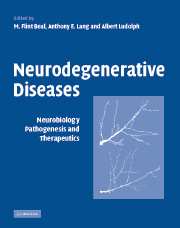Book contents
- Frontmatter
- Contents
- List of contributors
- Preface
- Part I Basic aspects of neurodegeneration
- Part II Neuroimaging in neurodegeneration
- Part III Therapeutic approaches in neurodegeneration
- Normal aging
- Part IV Alzheimer's disease
- 27 Mild cognitive impairment
- 28 Alzheimer's disease: overview
- 29 The neuropathology of Alzheimer's disease in the year 2005
- 30 Genetics of Alzheimer's disease
- 31 The role of ß-amyloid in Alzheimer's disease
- 32 Treatment of Alzheimer's disease
- Part VI Other Dementias
- Part VII Parkinson's and related movement disorders
- Part VIII Cerebellar degenerations
- Part IX Motor neuron diseases
- Part X Other neurodegenerative diseases
- Index
- References
32 - Treatment of Alzheimer's disease
from Part IV - Alzheimer's disease
Published online by Cambridge University Press: 04 August 2010
- Frontmatter
- Contents
- List of contributors
- Preface
- Part I Basic aspects of neurodegeneration
- Part II Neuroimaging in neurodegeneration
- Part III Therapeutic approaches in neurodegeneration
- Normal aging
- Part IV Alzheimer's disease
- 27 Mild cognitive impairment
- 28 Alzheimer's disease: overview
- 29 The neuropathology of Alzheimer's disease in the year 2005
- 30 Genetics of Alzheimer's disease
- 31 The role of ß-amyloid in Alzheimer's disease
- 32 Treatment of Alzheimer's disease
- Part VI Other Dementias
- Part VII Parkinson's and related movement disorders
- Part VIII Cerebellar degenerations
- Part IX Motor neuron diseases
- Part X Other neurodegenerative diseases
- Index
- References
Summary
Overview
Over the past decade medications have been approved for the treatment of Alzheimer's disease (AD). The first of these worked via cholinergic stimulation, and targeted the symptoms of attention and memory. More recently Memantine, an NMDA receptor antagonist, has been added to the list of approved medications for AD. These treatments provide symptomatic benefits. Initiative for new therapeutics target the characteristic neuropathological features of AD or other biological mechanisms that may reflect the etiology of the disease in the hope of identifying preventative or curative agents.
Research into treatment of AD tends to focus on interventions at the earliest stage of the disease and the concept of mild cognitive impairment (MCI), a prodrome to dementia, has become the target of many interventions. This approach has the added challenge of determining diagnostic specificity of an entity, which does not yet constitute a diagnosis. At the same time, interest in treating the more impaired patient has grown with the approval of the first drug with an indication for moderate to severe AD and with new studies examining cholinesterase inhibitors in more advanced patients.
Awareness that AD may coexist with other CNS diseases or be difficult to distinguish from dementia of other etiologies may have contributed to the interest in treatments for individuals with other conditions including vascular and mixed dementia.
- Type
- Chapter
- Information
- Neurodegenerative DiseasesNeurobiology, Pathogenesis and Therapeutics, pp. 459 - 470Publisher: Cambridge University PressPrint publication year: 2005

